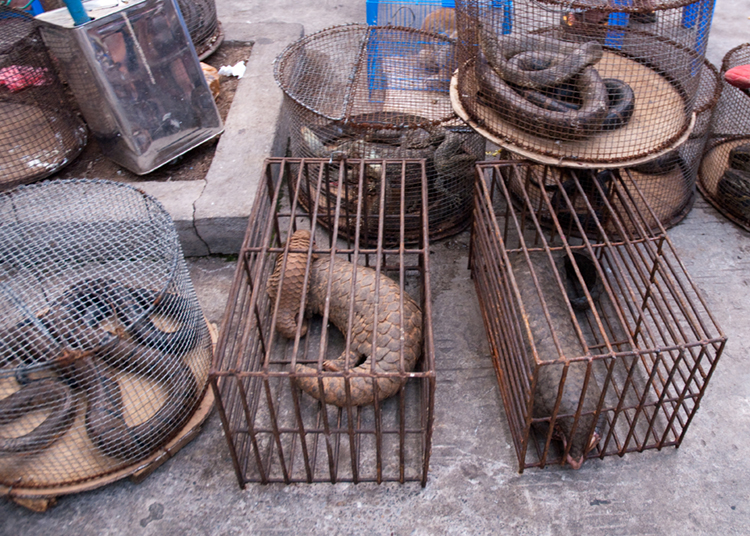The pangolin, a reclusive, unusual insect-eating animal, is the world’s most trafficked (illegally traded) mammal. These armored but endangered animals live in tree hollows or dense thickets in remote forests and scrublands of Africa and Southeast Asia. Shy and largely nocturnal, the cat-sized animals are hard to find—which is a lucky thing. The pangolin is prized for its meat and the medicinal properties of its scaly armor. Were pangolins easier to find, they would have disappeared from the Earth long ago. As people continue to hunt them, however, and as deforestation shrinks their natural habitats, the pangolin’s days may still be numbered.
Pangolins are slow-moving mammals that resemble anteaters and armadillos. However, they are not closely related to either, and, instead of the coarse hair of anteaters, pangolins have coats of overlapping brown scales. Like rhino horn, pangolin scales are largely composed of keratin, the same protein found in human hair and fingernails. Like anteaters, pangolins are toothless and have long, narrow snouts, long tails, and sticky, ropelike tongues that they thrust far out to catch ants, termites, and other tasty insects. Their large, strong foreclaws are used for ripping into tough ant and termite mounds and nests.
Pangolins are perhaps best known in popular culture for their unique defense mechanism. When threatened, they roll themselves into a tight, armored ball. With the exception of humans, few animals can harm pangolins. They are harmless animals, but they can also lash out with their scaly tails or emit a foul-odored scent like a skunk.

All eight pangolin species are threatened, and international laws and treaties protect their populations on paper. But the lucrative illegal trade powers on, and pangolins are being smuggled in record numbers. Poachers capture or kill hundreds of thousands of pangolins every year. And most of the animals—alive, maimed, or dead—are destined for China, where the meat is considered a delicacy and the scales are used in traditional medicine. Customs officials seize thousands of pangolins—often cruelly packed in tiny cages or boxes—and hundreds of pounds of pangolin scales each year. Despite its illegal nature, pangolin trafficking is often out in the open, even advertised. In June 2017, an Internet search revealed numerous traders on several websites selling pangolin scales, pangolin meat, and live pangolins. There is also an illegal trade in pangolin blood, and stuffed pangolins are unlawfully sold as souvenirs. Pangolins—like many wild animals—are also threatened by deforestation. They live in an ever-shrinking environment, leaving them with fewer places to hide from poachers.
And there is still more bad news for pangolins: they do not take well to captivity. Some animal populations can be saved or even restored in refuges, reserves, or zoos, but captured pangolins often simply die. They also do not reproduce in captivity, which prevents commercial breeding to supply China’s legal domestic medicinal trade. The only way to save these animals is to stop pangolin trafficking and preserve their natural homes.
Later this year, pangolins will be one of the topics at the Conference for the Convention on International Trade in Endangered Species of Wild Fauna and Flora (CITES) in Geneva, Switzerland. The goal is to list all pangolin species in Appendix I of CITES, which includes only species threatened with extinction. (Currently, two pangolin species are listed as critically endangered, and the others rank as vulnerable.) CITES is a treaty that aims to control trade in wild animals and plants, their parts, and products derived from them. Such a listing will draw more attention to the plight of pangolins, and it may encourage more people to help protect these humble creatures.
Untitled Document Can't view the linked articles? Subscribe to World Book Online

World Book Online delivers a progressive sequence of core databases supported by supplemental
tools, such as language translation, graphic organizers, and unique Webquests. Moving from
Early World of Learning to World Book Advanced, World Book Online aligns end-users with their
appropriate learning levels. Each stand-alone site provides additional features to support the
needs of users’ specific capabilities.
The World Book Difference
World Book combines cutting-edge technology with traditional editorial excellence to produce
authoritative, trustworthy, and unbiased content. The digital content is updated in real time and
carefully curated for each learning level. Accessible 24/7, the content is available on a variety of devices.
World Book Online combines 21st-century instructional techniques with timely information.
By breaking down complex topics and using easily understandable text, World Book Online helps to
build fluency and increase comprehension. Featuring single sign-on capability, these sites are paired
with highly visual content to engage even the most reluctant reader. Our collection of resources kindles
a lifelong learning experience for every user. This adherence to clarity, currency, and accuracy makes
World Book’s digital offerings an information hub for the classroom, library, and beyond.
Image 1: Pangolins are famous for their scaly armor and the habit of rolling up in a ball when threatened. Credit: © Shutterstock
Image 2: Pangolins and other illegally trapped wildlife suffer in cages in a market in Mong La, Myanmar, on the Chinese border. Credit: Dan Bennett (licensed under CC BY 2.0)